
Merchants' Exchange
The first structure known as "the Exchange" in New York was built the 17th century. It was a covered marketplace located near the foot of Broad Street. The Royal Exchange was built near the same place in 1752.
A project of erecting a merchants’ exchange in New York City was brought before a committee in the Chamber of Commerce on July 3, 1821, which was approved. The Merchants’ Exchange Company was incorporated on January 27, 1823.
By April 1824, the directors of the Merchants’ Exchange Co. purchased the Thomas Buchanan property in Wall Street, between Hanover and William streets, for the construction of the building. It had a frontage of 114 feet and extended back to Sloat Lane (see Major Holland 1776 map), renamed Exchange Street, in 1825, and Exchange Place in 1827.
Continue below...

1827 - 1835

|
Copyright © Geographic Guide - NYC 19th Century, Images and History. |
The projected Merchants' Exchange, designed by Josiah R. Brady, watercolor by Alexander Jackson Davis, probably 1826. Source: Metropolitan Museum of Art.
In 1824, the trustees of the Merchants' Exchange decided on illuminating the building with gas and a large light would be placed on the top of the dome to serve as a beacon for ships arriving at the port. H. I. Wyckoff, was the Chairman of the Building Committee.
In April, 1825, carpenters and masons were engaged in tearing down and clearing away the buildings in Wall Street, to make way for the Merchants' Exchange building. The foundation stone was laid in the same month.
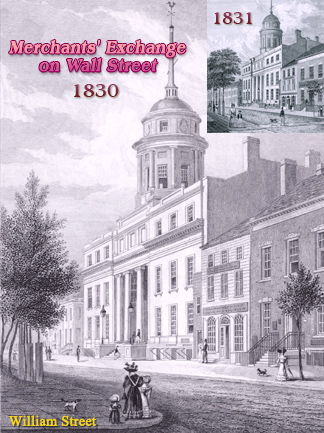 On December 23, 1825, the Street Committee of the Common
Council resolved that the name Slote Lane [Sloat Lane is also used in this
petition] be changed to Exchange Street (after the Merchants Exchange Building).
This resolution originated from a petition of the owners of properties on Sloat
Lane "praying that its name may be changed to that of Exchange Street and that
the same be regulated and paved". On May 21, 1827, a petition to change the name
of Garden Street, between William St. and Pearl St., to Exchange Place was
approved by the Common Council. On September 22, 1828, the Common Council
resolved to take measures for opening Exchange Place and continuing it to Wall
Street along the south-easterly side of the “Merchants Exchange Buildings.”
On December 23, 1825, the Street Committee of the Common
Council resolved that the name Slote Lane [Sloat Lane is also used in this
petition] be changed to Exchange Street (after the Merchants Exchange Building).
This resolution originated from a petition of the owners of properties on Sloat
Lane "praying that its name may be changed to that of Exchange Street and that
the same be regulated and paved". On May 21, 1827, a petition to change the name
of Garden Street, between William St. and Pearl St., to Exchange Place was
approved by the Common Council. On September 22, 1828, the Common Council
resolved to take measures for opening Exchange Place and continuing it to Wall
Street along the south-easterly side of the “Merchants Exchange Buildings.”
On May 1, 1827, the Merchants' Exchange was open for business and the building was completed in July. It was one of the largest edifices in New York City at the time, rising 120 feet high from the street to the top of its colonnaded cupola.
The Merchants' Exchange building was designed by Martin Euclid Thompson (1786–1877) with contribution of Josiah R. Brady (ca. 1760–1832) and drawings by the young artist Alexander Jackson Davis (1803-1892), later also a renowned architect. Thompson was a carpenter and builder before becoming a student of New York City architect Joseph R. Brady, an early adopter of the Greek Revival style.
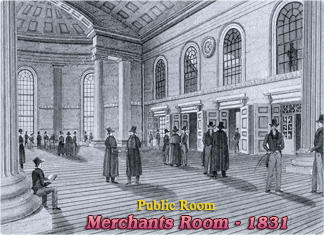 The Merchants' Exchange building stood
on the south side of Wall Street with 115 ft of the block front between William
and Hanover streets. It had two stories and attic above an elevated basement, and
extended 150 ft south to Exchange St., where there was a frontage of 114 ft. The
main front on Wall St. was of Westchester marble. The first and second floors were of
the Ionic order, from the temple of Minerva Polios, at Priene, in Ionia. A recessed elliptical
portico, 40 feet wide, was in front in Wall Street. A screen of four columns and
two antae, each 27 feet high and 3 feet 4 inches in diameter above the base,
composed of a single block of marble, extended across the foot of the portico,
supporting an entablature of six feet in height, on which rested the third
floor, making a height of 60 feet from the ground. The principal entrance to the
rotunda and exchange room was by a flight of ten or nine marble steps, with a pedestal
at each end. On ascending to the portico three doors opened to offices. The
vestibule was of the Ionic order, from the little Ionic Temple of Illyssus. The
exchange room, which was the rotunda, was 75 ft. long, 55 ft. wide, and 45 ft.
high, to which were attached four principal rooms, including the reading-room,
in which could be found most of the political and commercial journals of the
United States. In the rear of the
rotunda, another room was used for auction sales of real estate, shipping, and
stocks. To the right of this, after ascending a flight of stairs, the saloon, in
which the Board of Brokers assembled daily, presented itself to the spectator.
The cupola was 24 feet in diameter. From its most elevated part the entire city
could be seen.
The Merchants' Exchange building stood
on the south side of Wall Street with 115 ft of the block front between William
and Hanover streets. It had two stories and attic above an elevated basement, and
extended 150 ft south to Exchange St., where there was a frontage of 114 ft. The
main front on Wall St. was of Westchester marble. The first and second floors were of
the Ionic order, from the temple of Minerva Polios, at Priene, in Ionia. A recessed elliptical
portico, 40 feet wide, was in front in Wall Street. A screen of four columns and
two antae, each 27 feet high and 3 feet 4 inches in diameter above the base,
composed of a single block of marble, extended across the foot of the portico,
supporting an entablature of six feet in height, on which rested the third
floor, making a height of 60 feet from the ground. The principal entrance to the
rotunda and exchange room was by a flight of ten or nine marble steps, with a pedestal
at each end. On ascending to the portico three doors opened to offices. The
vestibule was of the Ionic order, from the little Ionic Temple of Illyssus. The
exchange room, which was the rotunda, was 75 ft. long, 55 ft. wide, and 45 ft.
high, to which were attached four principal rooms, including the reading-room,
in which could be found most of the political and commercial journals of the
United States. In the rear of the
rotunda, another room was used for auction sales of real estate, shipping, and
stocks. To the right of this, after ascending a flight of stairs, the saloon, in
which the Board of Brokers assembled daily, presented itself to the spectator.
The cupola was 24 feet in diameter. From its most elevated part the entire city
could be seen.
The façade on Wall Street projected by the architects, before construction, can be seen above in the drawing by A. J. Davis. The façade of the erected building was slightly different as can be verified in a later drawing by Davis, published in 1828 by A. T. Goodrich.
In June 1826, with the Merchants' Exchange under construction, the post office already occupied a portion of the basement. It also occupied two-thirds of the southeast portion of the building on Exchange Place. Beneath, on each side of the portico, was a passage through the basement story to the post office and Exchange Place. By 1830, the cupola of the of the Merchants' Exchange building was used for a telegraph station, where signals were exchanged with the signal-poles on Staten Island (see wired cityscapes). For that purpose, a pointed structure was added to the cupola.
The Chamber of Commerce held its first meeting, in May, 1827, in its new offices, in the Merchants’ Exchange. Its headquarters remained there until the fire of 1835.
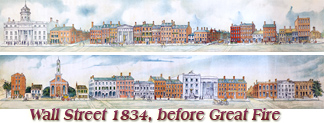 The home of the “New
York Stock and Exchange Board” was in the Merchants’ Exchange since it ready
for occupancy in 1827, until the building burned in 1835.
The home of the “New
York Stock and Exchange Board” was in the Merchants’ Exchange since it ready
for occupancy in 1827, until the building burned in 1835.
In February 1829, the architectural firm of Ithiel Town (1784-1844), former partner of Martin Euclid Thompson, and Alexander Jackson Davis (1803-1892) was formed with offices in the Merchants’ Exchange.
 The Merchants' Exchange hired
the English sculptor Robert Ball Hughes (1804-1868) to carve a
statue of Alexander Hamilton (1755-1804), one of the Founding Fathers of the
United States. Hughes arrived in New York in 1829 and began sculpting the marble statue in late 1831,
after the single block of Carrara marble arrived. A fund was raised by
subscription among merchants.
The Merchants' Exchange hired
the English sculptor Robert Ball Hughes (1804-1868) to carve a
statue of Alexander Hamilton (1755-1804), one of the Founding Fathers of the
United States. Hughes arrived in New York in 1829 and began sculpting the marble statue in late 1831,
after the single block of Carrara marble arrived. A fund was raised by
subscription among merchants.
The intention to install a statue of Hamilton at the Merchants' Exchange existed before the building opened in 1827. By May 1826, a model in miniature of a statue of Hamilton by sculptor N. Gevelot was exhibited in Philadelphia, intended to be submitted to the committee of merchants of the New-York Exchange. On May 20, 1826, the U.S. Congress approved an act authorizing the importation of statues of George Washington and Alexander Hamilton, free of duty.
The Hughes' statue was installed near the center of the rotunda and unveiled by April 1835, with the inscription: Erected to the Memory of Alexander Hamilton, by the Merchants of the City of New York, in the Exchange, in Wall-Street. It was about 15 feet high, including the base. He was represented holding a scroll with hair in the style of the ancient Greeks. The monument was lost eight months later in the fire of December 1835. The illustration on the right from the NYPL, was drawn and engraved by Adams, who claimed it was the correct representation of the statue. It was published on the front page of the New-York Mirror, on October 24, 1835. An article about the statue was published in the New York Commercial Advertiser, on April 20, 1835, which fits the characteristics of the statue of the Adams' drawing.
 On
the night of December 16, 1835, about nine o'clock pm, a fire started in a large
warehouse at 25 Merchant Street (now Beaver Street). One hour later, several
buildings were engulfed in flames. The fire reached the dome of the Exchange
about half-past one o'clock, after having raged in the vicinity for five hours.
The basement and the rotunda were covered with goods, which had been carried
there for safety, no one imagining that the fire could spread so long. About
four o'clock, the dome fell, crashing all beneath it, including the statue of
Hamilton.
On
the night of December 16, 1835, about nine o'clock pm, a fire started in a large
warehouse at 25 Merchant Street (now Beaver Street). One hour later, several
buildings were engulfed in flames. The fire reached the dome of the Exchange
about half-past one o'clock, after having raged in the vicinity for five hours.
The basement and the rotunda were covered with goods, which had been carried
there for safety, no one imagining that the fire could spread so long. About
four o'clock, the dome fell, crashing all beneath it, including the statue of
Hamilton.
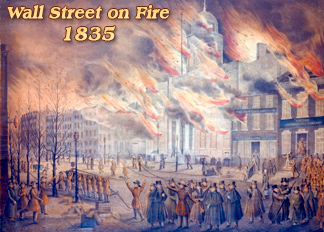 On December 21, 1835, the New York Commercial Advertiser
reported: "A gallant effort was made to save the statue of Hamilton by a young
officer from the navy yard with a party of four or five sailors. They had
actually succeeded in removing it from the pedestal, when the danger from the
approaching fall of the roof, compelled them to seek safety in flight."
On December 21, 1835, the New York Commercial Advertiser
reported: "A gallant effort was made to save the statue of Hamilton by a young
officer from the navy yard with a party of four or five sailors. They had
actually succeeded in removing it from the pedestal, when the danger from the
approaching fall of the roof, compelled them to seek safety in flight."
On December 17, 1835, the members of the N. Y. Stock and Exchange Board, which had held its sessions in the Merchants’ Exchange, met at John Warren’s office, and voted to suspend all operations for the week, and appointed a committee to secure rooms. On December 19, the Merchants’ Exchange was held at the Mechanics’ Exchange in Broad Street. The post-office was removed to the Rotunda in Chambers Street.
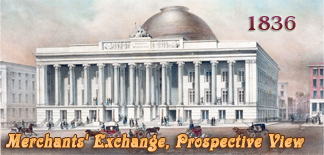 In the early 1840s, a new Merchants' Exchange building was completed on
the same site.
In the early 1840s, a new Merchants' Exchange building was completed on
the same site.
Merchants' Exchange